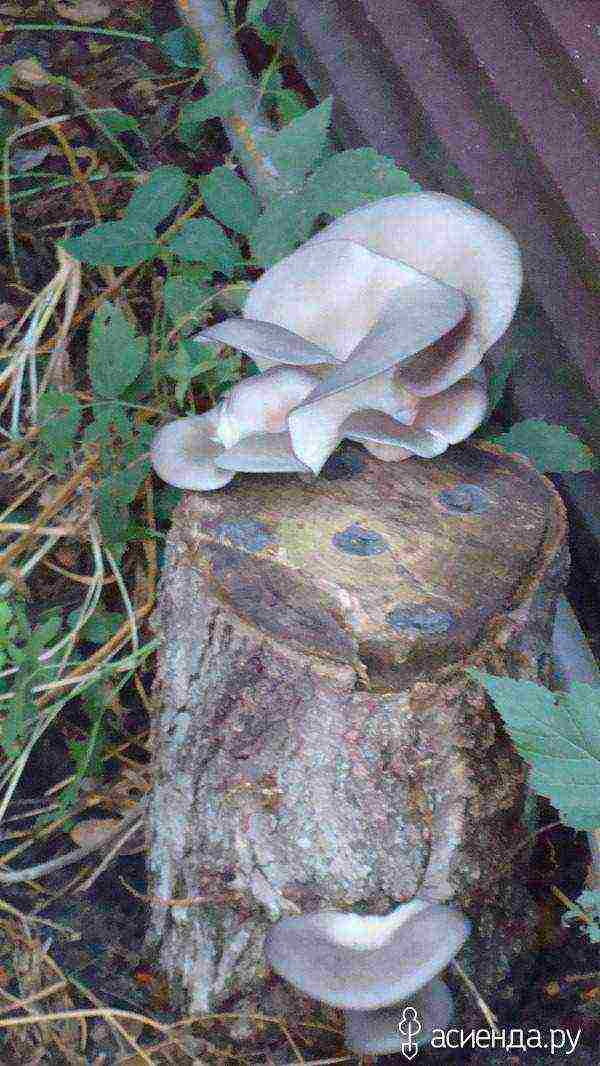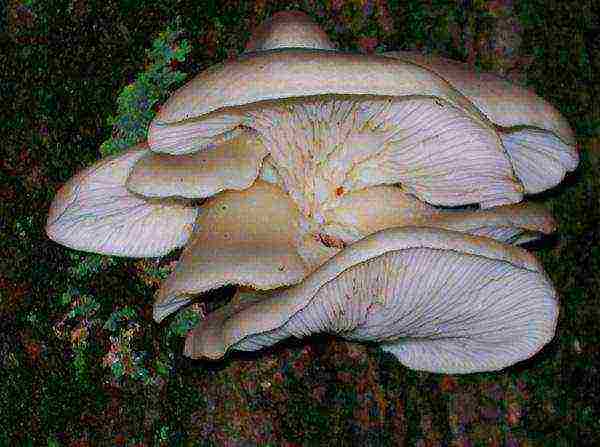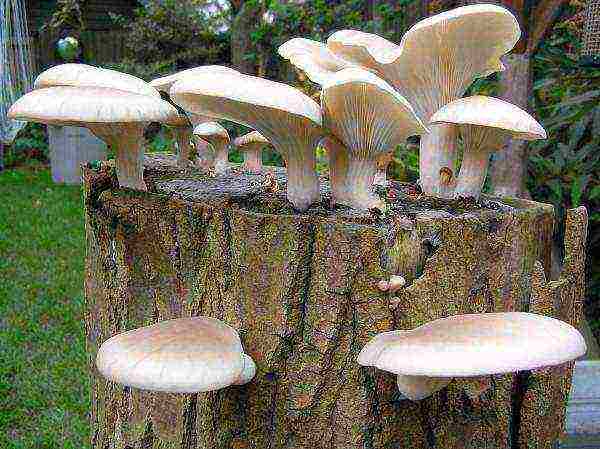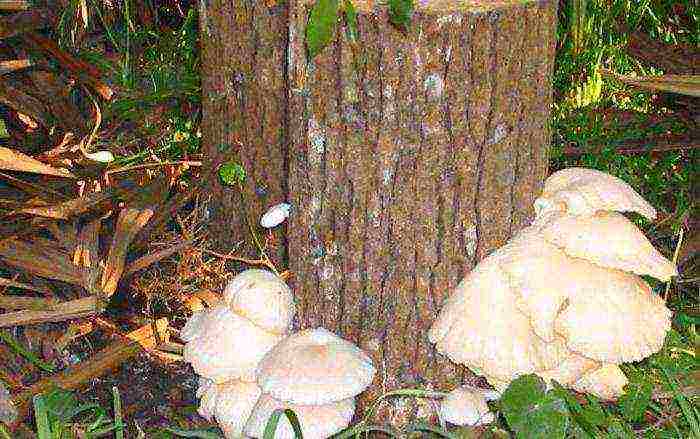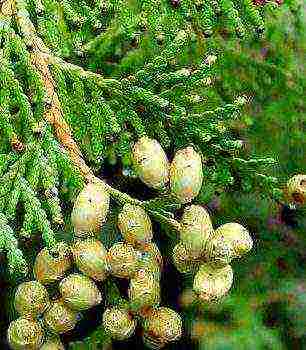Content
The content of the article:
- Growing mushrooms on stumps at home
- What mushrooms can be grown on tree stumps?
- Preparing for planting mycelium
- Mycelium cultivation technology
- Where to place the plantation?
- The successes of the mushroom industry in Russia
Any reproduction of various mushroom cultures involves several basic cultivation methods. One of the easiest and most effective methods is the cultivation of mycelium using forest waste. The most practical is the use of stumps of different types of trees on which it grows in nature. This cultivation method is called extensive. It implies the course of the growing process in natural conditions, under the open sky. In rare cases, this can be done in a basement. With this option, monetary investments and material and technical base are minimal, and the yield is quite high. However, this will depend on the climatic conditions in which you are located.
Growing mushrooms on stumps at home
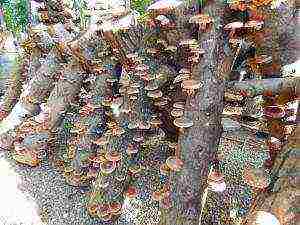 The extensive reproduction technique is well suited for home use. Taking into account the peculiarities of this technology, it is possible to achieve large production scales, but it is quite often used to satisfy only household needs. The landing of several dozen families will regularly supply you and your relatives with a quality product. Industrial production volumes can be achieved through high optimization and the use of the most productive genera.
The extensive reproduction technique is well suited for home use. Taking into account the peculiarities of this technology, it is possible to achieve large production scales, but it is quite often used to satisfy only household needs. The landing of several dozen families will regularly supply you and your relatives with a quality product. Industrial production volumes can be achieved through high optimization and the use of the most productive genera.
What mushrooms can be grown on tree stumps?
Under certain conditions, almost all types of mycelium are capable of growing on wood. Mushroom yields will vary considerably. In practical plant growing today, it is customary to cultivate two types of edible mushrooms: oyster mushrooms and honey agarics. However, it is most advisable to grow oyster mushrooms. This genus of wild plants gives the highest yield and cyclicality throughout the year. The technology of reproduction of different genera of this kingdom of botany on wood blocks is identical. Only the natural ability of various mycelium variants to bear fruit in a woody environment differs.
Preparing for planting mycelium
To carry out the procedure for infecting a timber stock with a seed mixture, a minimum amount of materials is required:
- Wooden log.
- Mycelium.
- Ancillary equipment.
For the purpose of cultivation, you can pick up any options for low-grade wood. But it is better to prepare those varieties on which the spores prefer to grow in natural conditions. The logs should not be more than 1-2 years old. It is advisable to choose options with minimal signs of destruction, since mushrooms wear out the tree very aggressively and your growing environment will quickly exhaust its resource.
It is best to cook a damp and fairly fresh breed. The diameter of the blanks can vary from 15 to 30 cm. The optimal option is 20-25 cm. As mentioned, the most economically profitable family for home and industrial production is oyster mushroom. Mycelium of this kind is realized in several forms: various containers, plastic bags.
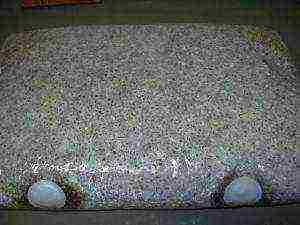 The main nuances worth knowing about are the substrate on which the mycelium is grown. The main types are: cereal grains, sawdust, bars, corn cobs. There is an opinion that the most promising option is a sowing medium grown on grains. However, no significant differences were found in base modifications.Storage of the cultivation substrate should not exceed 6-7 months. Otherwise, the prospect of reproduction of the dispute is reduced. It is best to plant fresh, healthy material.
The main nuances worth knowing about are the substrate on which the mycelium is grown. The main types are: cereal grains, sawdust, bars, corn cobs. There is an opinion that the most promising option is a sowing medium grown on grains. However, no significant differences were found in base modifications.Storage of the cultivation substrate should not exceed 6-7 months. Otherwise, the prospect of reproduction of the dispute is reduced. It is best to plant fresh, healthy material.
The main requirements for storing mycelium are temperature (+ 2 ° C) and humidity. A quality planting substrate is a white conglomerate that is hard to the touch. If it is significantly changed, then there will be no harvest. The extensive method involves the use of micelated gruel or water, which is easy to pour into the seating nests. The tools with which you will prepare logs for infection can be varied. Your best bet is to have:
- drill;
- chainsaw;
- industrial film;
- locksmith staple;
- container for sterilizing logs.
Mycelium cultivation technology
For sowing oyster mushrooms or other genera, wooden logs are harvested, which are sawn into blocks of 30-40 cm, pre-soaking them in ordinary water for 1-2 weeks. If the blanks are freshly cut logs, then they do not need to be soaked. The entire infection algorithm boils down to the following basic manipulations:
- Digestion of wooden blocks.
- Cutting out niches of primary growth.
- Seed medium preparation.
- Infection.
- Log wrapping.
To prevent the competitive growth of various microorganisms with fungi in the environment of wood and the destruction of antifungal substances, the method of heat treatment of the bar is used. To do this, place the logs in boiling water for 15-30 minutes.
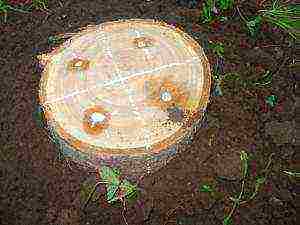 For a better invasion of spores into a wooden blank and protecting it from adverse external influences, it should be correctly placed in a log. For this, several methods are used. The first, and the simplest, consists in placing the mycelium on the end of the bar and laying on top of the next one. Thus, an artificial trunk is formed, in which each next layer protects the mycelium of the previous one. Straw or sawdust is laid on the surface of the uppermost one.
For a better invasion of spores into a wooden blank and protecting it from adverse external influences, it should be correctly placed in a log. For this, several methods are used. The first, and the simplest, consists in placing the mycelium on the end of the bar and laying on top of the next one. Thus, an artificial trunk is formed, in which each next layer protects the mycelium of the previous one. Straw or sawdust is laid on the surface of the uppermost one.
The second method is the imposition of holes on the log, which serves as a protection. To do this, use a conventional drill to drill several holes up to 1-15 cm in diameter to a depth of 10 cm. The method of sawing the upper layer of the bar is also used. For its implementation, a 4-centimeter layer of log is cut down. The mycelium is placed on it and covered like a lid. Then fix it with nails.
To achieve the desired consistency, the mycelium is ground by hand and tightly placed in niches for cultivation. Then they are tightly sealed with wooden valves or paper wads for better incubation.
The micellar environment constantly requires a certain water content for growth. The logs must be kept at 80% moisture for growth to be successful. To preserve this environment, the hemp is wrapped in plastic wrap and fixed with staples. For good incubation, the workpieces are placed in a basement or in a building with minimal direct sunlight.
Where to place the plantation?
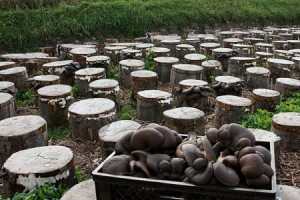 The bars are overgrown in 2 - 2.5 months. After about this time, the first traces of young growth appear on them. This is a good sign. Now the logs can be installed in their place of permanent residence. This is best done in a shaded garden. There they are buried to a depth of 10 cm. Now that your mushroom garden is ready, you need to periodically water it in very dry weather and harvest.
The bars are overgrown in 2 - 2.5 months. After about this time, the first traces of young growth appear on them. This is a good sign. Now the logs can be installed in their place of permanent residence. This is best done in a shaded garden. There they are buried to a depth of 10 cm. Now that your mushroom garden is ready, you need to periodically water it in very dry weather and harvest.
The successes of the mushroom industry in Russia
Taking into account the traditional use of oyster mushrooms, whites and other species of this plant organism in the Russian diet, mushroom cultivation is one of the most promising directions in plant growing. Every year the share of Russian companies in the segment of this type of production is significantly increasing.
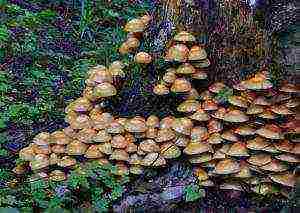 In 2015, the supply of this kind of food products increased by 22%.The departure of foreign importers from the Russian market provides an excellent opportunity for domestic manufacturers, the volume of supplies of which covers only 10-15% of the Russian market. Companies involved in this segment show successful and stable economic growth. Some of the most successful mushroom growing enterprises in Russia are the industrial groups of the Moscow region and the Upper Volga region. Companies that occupy a large part of the Russian market show a constant increase in production and high profits: the Zapadny refrigeration plant (TM 4 seasons), Ledovo (TM Snezhana), Ledoy Mir (TM Smak), Khladokombinat No. 1 "(St. Petersburg)," Elikom ".
In 2015, the supply of this kind of food products increased by 22%.The departure of foreign importers from the Russian market provides an excellent opportunity for domestic manufacturers, the volume of supplies of which covers only 10-15% of the Russian market. Companies involved in this segment show successful and stable economic growth. Some of the most successful mushroom growing enterprises in Russia are the industrial groups of the Moscow region and the Upper Volga region. Companies that occupy a large part of the Russian market show a constant increase in production and high profits: the Zapadny refrigeration plant (TM 4 seasons), Ledovo (TM Snezhana), Ledoy Mir (TM Smak), Khladokombinat No. 1 "(St. Petersburg)," Elikom ".
The success of these and many other farms lies in the high demand for this product and the rather easy technological process of growing. The market in our country has a large deficit in this sector and is one of the most promising in the economy. The peculiarities of obtaining the product make it possible to achieve high profitability and payback of the goods. Most of the regions in the country are suitable for this type of business. Government programs and subsidies stimulate the development of large manufacturing companies and small private farms.
In recent years, more and more people have begun to master technologies that allow collecting oyster mushrooms on stumps. Growing these mushrooms at home does not require any special knowledge and skills. After reading this article, you will learn about the main stages of this process.
Mycelium selection
To collect oyster mushrooms on stumps, cultivation must begin with the acquisition of high-quality planting material. Some vendors offer to buy mycelium on sticks. However, long-term practice has shown that when using them, the first harvest can be obtained only after two years, and sometimes even later. Therefore, experts recommend purchasing fresh mycelium from oats or wheat. When choosing such planting material, you must make sure that there is no gray-green mold on it, the excess of which indicates the poor quality of the offered product.
When is it better to plant oyster mushrooms on stumps?
It is advisable to start growing these mushrooms in the autumn months. It is during this period that they do not require frequent watering, and the crop ripens much faster. If, with spring sowing, it will be possible to feast on mushrooms after a year and a half, then with autumn sowing - just a year later. In the first six months, oyster mushrooms require special care, which consists in frequent watering.
All of the above does not mean that you need to abandon the spring sowing of mycelium. It's just that in such cases, the logs with the future harvest are not buried in the ground, but placed in the basement and covered with wet burlap so that they gradually become overgrown with mycelium. In the fall, they are taken out of the cellar and buried in the ground.
Sowing technology
It should be understood that growing oyster mushrooms at home on stumps is a long and laborious process. In this case, you can only get a seasonal harvest, depending on climatic and weather conditions. The preparation of stumps must begin at the end of January. It is advisable to choose those on the surface of which there are no signs of mold. Before adding planting material, the logs should be soaked in water for three days. This will create the increased moisture required for the mycelium to be set. Stumps with mycelium can be taken out into the garden no earlier than May, when the threat of frost will completely disappear.
To get a good harvest of oyster mushrooms on stumps, cultivation and sowing can be carried out in several different ways:
- Holes are made in the logs, the depth of which is about six centimeters, and the diameter is about ten millimeters. Then they are filled with mycelium in grains and covered with moss or scotch tape.
- Planting material is laid out on the end of the stump and covered with a disc previously cut from a log, the thickness of which is about three centimeters, and then fixed with nails.
- A pyramid is built from the chocks, and the end of each log is covered with a two-centimeter layer of mycelium.
After sowing, the stumps are placed in a cellar and covered with burlap or foil.
Growing oyster mushrooms on stumps in the basement
In order for your venture to be crowned with success, it is necessary not only to choose the right mycelium, but also to create optimal conditions in the room chosen for these purposes. It is important that the air temperature in the basement is at least fifteen and no more than twenty degrees, and the humidity is within 80-95%.
It is recommended to pay special attention to providing good ventilation and lighting. It should also be understood that growing oyster mushrooms on stumps in the basement implies insulation and re-equipment of the room. To avoid carbon dioxide build-up, it is imperative to install fans. It is advisable to use fluorescent lamps as lighting devices. To place blocks with mushrooms in the basement, special racks should be equipped in advance. It is preferable that they are made of durable plastic that is resistant to moisture.
Transplant to open ground
In May, hemp with oyster mushrooms can be moved to the garden. The readiness for landing on open ground can be judged by the presence of a dense white bloom. For the most successful fruiting of myceliums, it is advisable to put the logs in the shade, for example, under densely leafy trees.
Wet leaves are lined at the bottom of the pre-dug pits, and then stumps are planted. It is important that the embedment depth of the logs does not exceed fifteen centimeters. The distance between adjacent chocks should be about half a meter. Further care of the plantings consists in periodically moistening the soil around the logs. The first crop can be harvested at the beginning of autumn.
With the onset of winter, it is recommended to wrap the hemp with spruce branches, leaves or straw. A similar mycelium will bear fruit abundantly for several years in a row. The maximum mushroom harvest can be harvested in the second and third years.
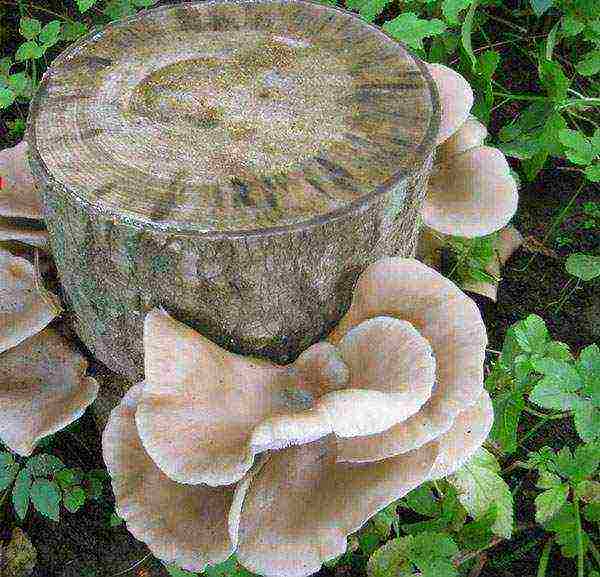 In nature, fungi parasitize on tree trunks. Their mycelium filaments can spread over long distances. The area of an adult mycelium ranges from 10 m2 to 15 m2, depending on the type of fungus. Oyster mushrooms are mushrooms that are unpretentious to growing conditions. Their spores infect deciduous trees. The mycelium can spread to the straw of cereals, such as wheat, as well as to sawdust of birch or oak.
In nature, fungi parasitize on tree trunks. Their mycelium filaments can spread over long distances. The area of an adult mycelium ranges from 10 m2 to 15 m2, depending on the type of fungus. Oyster mushrooms are mushrooms that are unpretentious to growing conditions. Their spores infect deciduous trees. The mycelium can spread to the straw of cereals, such as wheat, as well as to sawdust of birch or oak.
At their summer cottage, mushrooms are grown on stumps. They use firewood that was harvested a month ago. The logs are still wet and the bark can be easily removed from them, but most of the stump is already dry. Such wood is ideal for the development of mushroom mycelium.
Fungal spores can infect healthy trees in the garden. If the mycelium spreads to fruit trees, their yield will decrease significantly, and three to four years after infection, the tree will die. Therefore, stumps with mushroom spores are placed away from the garden in a shaded place, for example, under the wall of a house.
Stump preparation
To grow mushrooms, you need to prepare the wood. Stumps with a diameter of 25 cm and a length of 50 cm are infected with spores. The stumps are sawn into three parts. Several holes are made in the first cut.
Use a nib drill. It is very difficult to drill holes with a conventional cartridge nozzle, since the wood is still wet. The depth of the holes must be at least 5 cm.
On the other side of the saw cut with a circular or gasoline saw, make several longitudinal and transverse cuts of the same depth. You will get a kind of mesh. Nails are hammered along the diameter of the logs, the caps of which are removed with nippers. Then they do a few simple steps:
- the first part of the log is filled with mycelium;
- then it is placed in the prepared hole with the holes down;
- a layer of mycelium is applied to the first part of the log;
- cover with the second part of the stump;
- another layer of mycelium is applied;
- cover with the last part of the stump.
The joints of the logs are wrapped with tape to protect the mycelium from ants.In order for the spores to germinate and give a fruiting body, the stumps infected with mycelium are placed in a shaded place on the site. After two months, you can harvest oyster mushrooms, provided that the logs are constantly moistened. They are watered every week.
Set up drip irrigation for stumps. Then the stumps do not have to be monitored until the harvest. Use a feather drill to make a groove in the third part of the log for the diameter of the neck of the plastic bottle. Cut off the bottom of the bottle, place it in the recess and fill with water.

Today I want to show you how I grow mushrooms at home - oyster mushrooms.
It is very simple and not troublesome. Sow mycelium once and pick mushrooms for 3-5 years. With this method of cultivation, mushrooms turn out to be very fragrant - like grown in the forest and radically different in taste from store ones.
Each of you has the opportunity to grow eco-mushrooms in a garden plot on a stump.
I sowed mycelium for the first time 3 years ago - today is the fourth spring. This spring I decided to expand my plantations and at the same time tell everyone - because, as I always get asked a lot of questions.
Conifers are NOT SUITABLE for planting oyster mushrooms. The best for planting are deciduous trees: poplar, apple, cherry, oak, alder, beech, chestnut, ash, maple, poplar, birch, aspen, walnut.
Oyster mushroom grows especially well on walnut and poplar stumps.
The harder the wood, the longer the stump will last, and the more mushroom yields will grow on it.
The planting site for oyster mushrooms is a very important factor.
Oyster mushrooms do not really like places where the sun is too bright or a large open space. Therefore, it is better to plant oyster mushrooms under the trees in the garden. For example, oyster mushrooms grow well under a spreading walnut, well, or under other trees. Trees will shade the hemp with their crowns. Remember that the oyster mushroom planting site should be open to rainfall. This will save yourself the trouble of watering the mushroom garden.
You can use plots along the sheds and other structures on the north side.
Initially, I put stumps along the fence - between the building and the fence. There is a distance of about half a meter. It's enough. The main thing is not to put it under a canopy - so that the stumps are watered with rain.
To populate the mycelium, we need hardwood hemp - the size of the cuttings can be different - from 30 to 50 cm in length and 15 to 40 cm in diameter. The main thing is that the wood is healthy and there are no signs of mold infestation.
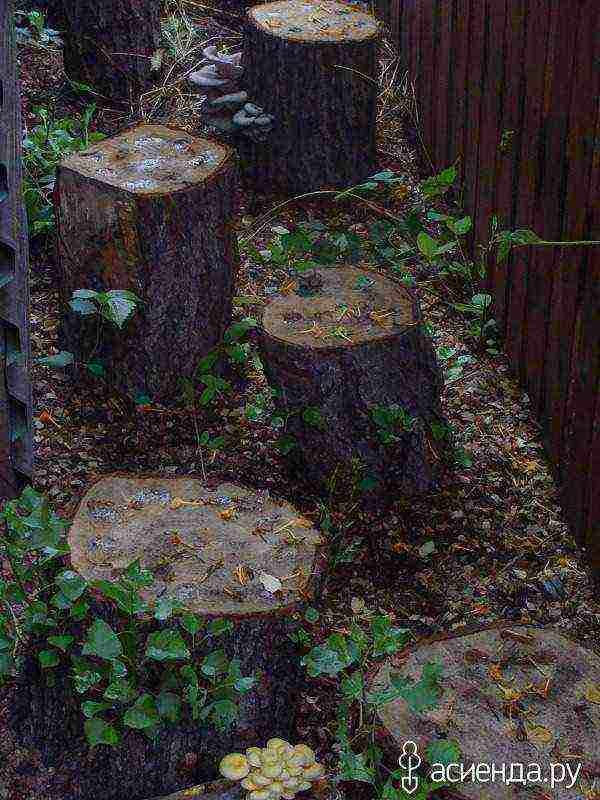
Prepare a tree stump for direct planting. It should be freshly cut, not old (dry). If the hemp is about a month old - place it in water for a day - so that it becomes wet. But, of course, it is better to use freshly sawn stumps for breeding oyster mushrooms. Then a successful result will be guaranteed.
We take the hemp, drill holes in them with a diameter of about 1-2 cm.It is possible smaller, but the smaller the diameter, the more difficult it is to fill the mycelium into it. Number in random order 6-8 holes on top and 4-6 holes on the side. IMPORTANT: The stump should stand vertically with its top up, that is, as a tree grew in nature, so put the stumps, do not change direction, turning the stumps upside down.

We fall asleep the mycelium. For convenience, we take a pencil (or other tamping device), put the mycelium into the holes, tamping it tightly with a pencil (stick, mortar, suitable in size) - do not worry, nothing will happen to the mycelium. The holes must be closed. You can close it in various ways - you can use plasticine, moss, duct tape, or, most conveniently, with a garden pitch. Some are even covered with cement. Mushrooms do not necessarily grow from these holes, they sprout inside the stump and come out anywhere
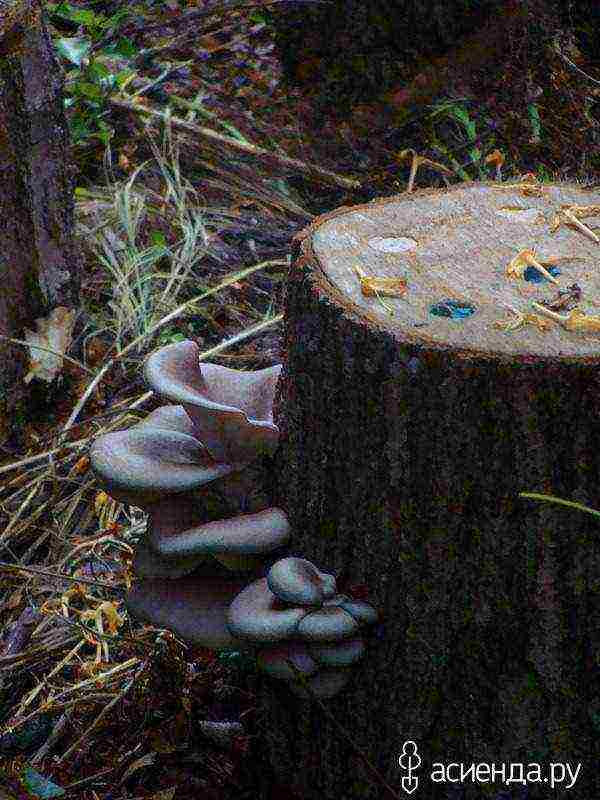
To install the stump, we dig a small hole - the depth is about 5 centimeters, put the stump in the holes and sprinkle the sides with earth. This is so that the stump is more stable and pulls moisture from the ground. Grass can grow around the stump.For more moisture, you can sprinkle around the mown grass, fallen leaves, etc., so that the soil remains moist longer.

They planted it, watered it around and that's it. We are waiting for the harvest.
If the summer is dry, the stumps can be watered. But do not pour water directly on the stump, mycelium does not like direct ingress of water, only moisture. That is, you can water the stumps with a fine spray
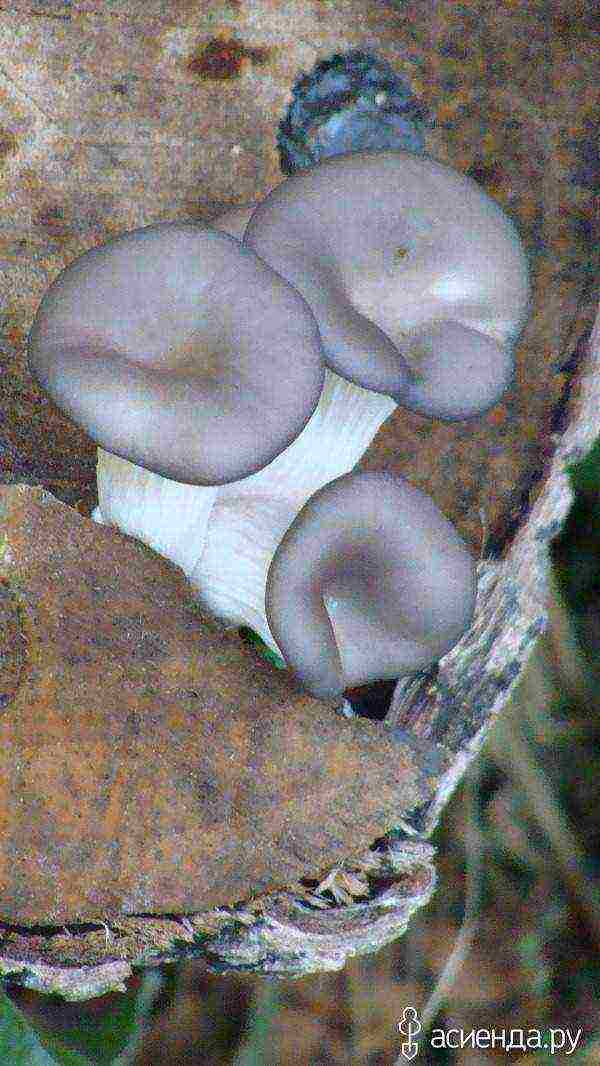
This year I decided to increase my mushroom plantation.
My husband just howled at my message that he needed to "prepare" the stumps again. By the way, it's not easy to drill them.
Buying mycelium in the society of mushroom growers, I got into a conversation with their technologist (gored me with questions) and he suggested to me a less laborious way to populate hemp with mycelium.
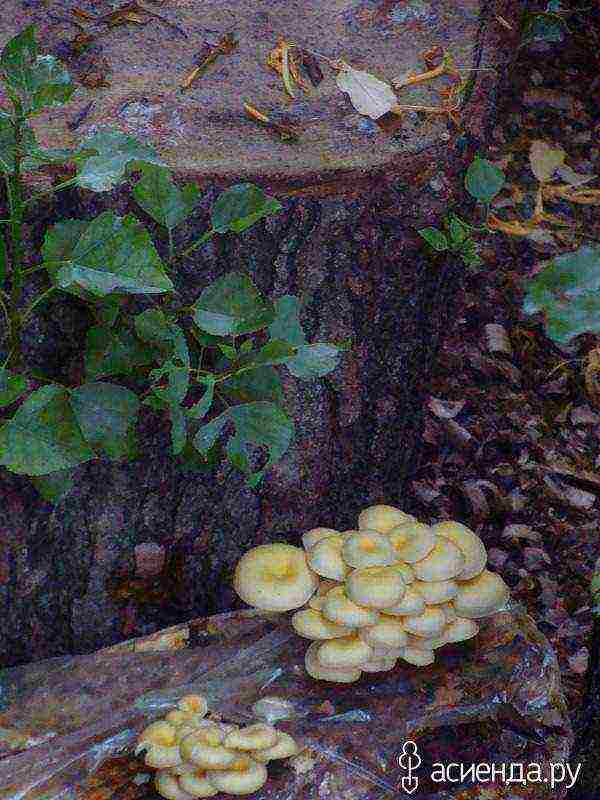
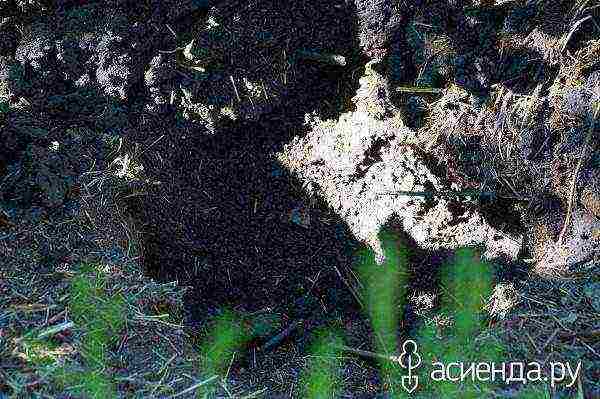
All ingenious is simple.
Digging a hole - a little less than a bayonet chipping - 15 centimeters, well 20.
The width is slightly wider than the harvested hemp.
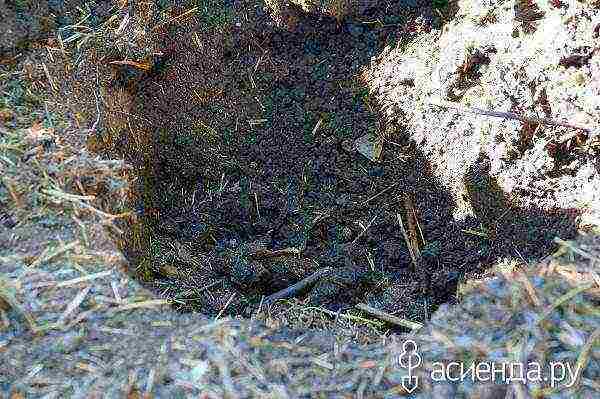
At the bottom we pour a pillow - 5 centimeters. It is possible a little more - not fundamentally.
This can be sunflower husks, dry moss, shavings or sawdust of deciduous trees.
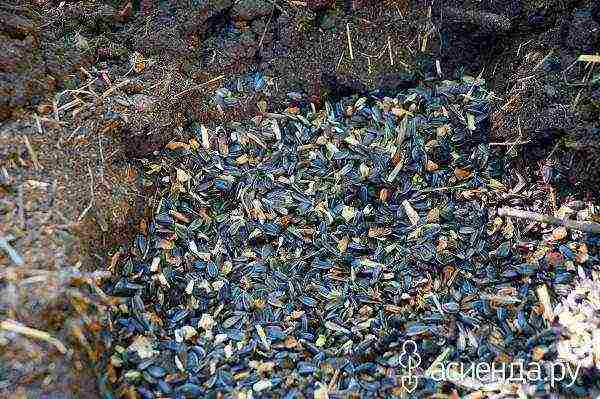
Water the hole with a pillow abundantly and pour mycelium on top - about 2 centimeters. About a handful of grain mycelium on a stump.

My mycelium is settled on a grain basis (wheat). I bought this mycelium from the mushroom growers' community in our city. A pack of mycelium - 2 kg costs 106 rubles today. This pack is enough for 5-6 hemp. You can search for mycelium online or search for a mushroom growing community in your area.

Prepared fossa

We put a stump on the mycelium.

Sprinkle the sides with earth (no need to tamp) and water abundantly around.
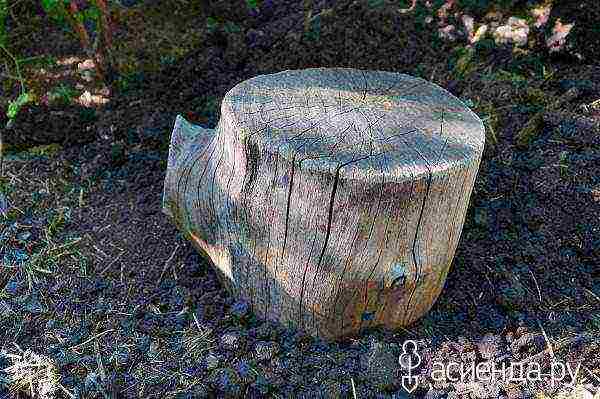
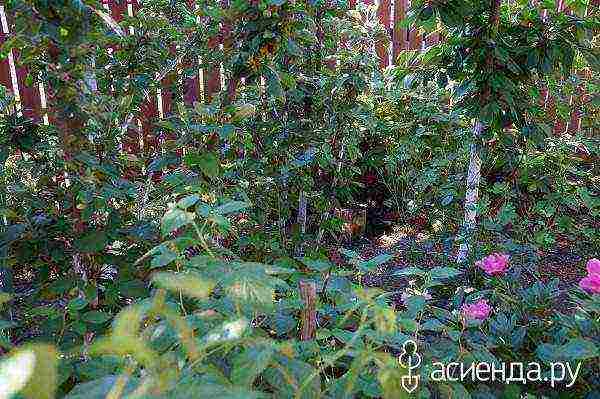
This is a general view of the place where I "planted" a stump this year - along the fence under the raspberry bushes, from above they give a shadow of the crown of large cherries.
A great place for stumps is under the spreading walnuts.
There is practically no need to look after your mushroom plantation.
Nature will take care of the good harvest itself. However, if the planting was done in the wrong place, for example, too sunny, periodic watering will be necessary.
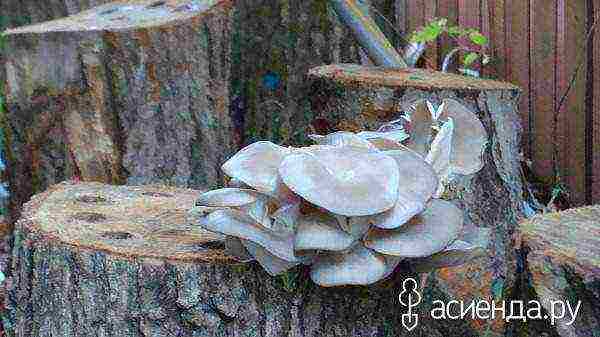
This method of growing oyster mushrooms will allow you to get a harvest of mushrooms in the same season. Moreover, you will receive mushrooms all year round - from the beginning of warm days to December (in the south, when there is no frost). Each stump will bear fruit until it completely disintegrates into parts. Such a mushroom plantation can feed you 3-5 years, but the largest harvests occur in the second and third years. Mushrooms with 10 stumps are more than enough for one family - and we fry and pickle and preserve for the winter.
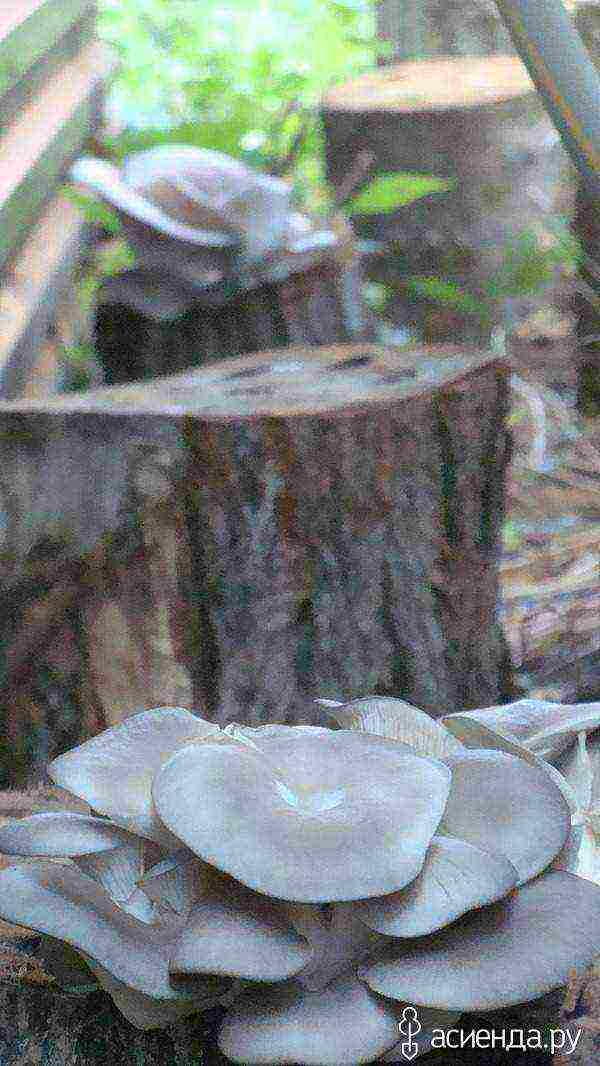
If stumps from felled trees remain on your site, you can use them, but they should be sown with mycelium only in April-May, when the temperature is above zero.
Oyster mushrooms on stumps during spring planting appear in August-September, and with a prolonged autumn, the harvest can be harvested until December. In cold regions for the winter, hemp is well covered with spruce branches, straw or foliage.
I'm not covering anything.
Now you know how to grow oyster mushrooms on stumps.
